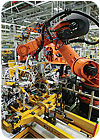
BMW Group (Munich, Germany) produces both 1 Series compact cars and 3 Series sedans at its plant in Regensburg, Germany. Long committed to automated assembly, the company recently decided to automate the handling of its front and rear axles, as well as the doors for both types of automobiles. Among other goals, BMW wanted a system that would be flexible enough to adapt to changing product requirements.
For handling the front and rear axles, BMW installed three heavy-duty, six-axis robots from Kuka Robots (Augsburg, Germany): a KR 500 model and two KR 360s. The KR 500, which has a payload of 500 kilograms, takes the assembled front axles from the production line and sets them down on an assembly aggregate carrier (known as a MAT). The KR 500's combination gripper is capable of working with the different axles that go into the 1 Series and 3 Series. It also secures the moving parts on the each axle during transport, so the various parts will be correctly position on the MAT for processing.
The KR 360 robots, which each have a payload of 360 kilograms, are responsible for handling the rear axles. The first KR 360 places the axles in a magazine on a combination workpiece-carrier. The second KR 360 then unloads the magazine and sets the axles down on the MAT. To ensure they are in the optimal position for their assigned tasks, the KR 360s are mounted on a pair of bases, each 1.5 meters high. They are equipped with grippers that can accommodate all the axle types that pass through the Regensburg plant.
For handling the car doors, BMW uses four KR 150 robots, which work in pairs. In each pairing, one KR 150 is assigned to the front doors and one to the rear doors. Each robot's sequence begins when an electric overhead conveyor arrives at the station with an empty hanger. One of the KR 150s then lifts the hanger out of the conveyor vehicle and moves it down a level, ready for loading. A pair of operators loads the required doors into the hanger and the robot reconnects the hanger to the conveyor.
Because of their high repeatability, the robots are able to avoid damaging either the doors or the conveyor, something that had been a problem in the past.
During typical operation, neither of the two pairs of robots is required to run at its maximum capacity. That way, if any of the robots break down or need to be stopped for maintenance, the remaining machines can take up the slack, avoiding any interruptions in production.
For more on robotic production, call 866-873-5852 or visit www.kukarobotics.com.